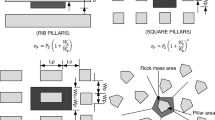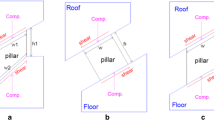Abstract
This paper describes the results of a back analysis of pillar failures at Troy Mine, Montana, and the use of this experience to make forward predictions on pillar stability in the nearby Montanore deposit which lies in a similar geomechanical setting. At Troy Mine, a progression of pillar failures in areas within the Middle Quartzite of the Revett formation led to the observed surface subsidence. The Troy Mine experience was used to understand the level of stresses and failure mechanism leading to the collapse of some pillars in the North Orebody to estimate pillar strength in quartzite beds within Troy’s mountainous terrain. The model elucidated that the dipping orebody geometry in relation to topography led to shear stresses in pillars at Troy Mine. Shear stresses resulted in significant loss of confinement in pillar cores (many theoretically in tension), even at width-to-height ratios that would be deemed stable under zero shear stress (flat seam under flat topography). A calibrated model was achieved, which allowed us to evaluate the impact that different pillar geometric characteristics (such as width, length, height, and shape) have on pillar performance under shear conditions for different depths and extraction ratios. Design charts were then generated to provide guidance on pillar geometry based on expected demand. Mine-wide models were developed to predict the level of vertical stress and horizontal shear stress for pillars in the different ore-bearing beds at Montanore. A sensitivity study was performed for various conditions, including extraction ratio, spatial location under the mountainous terrain, and local orebody geometry with the aim of performing a mine-wide evaluation of the factor of safety against shear. The results of the analyses performed in the present work show that the use of design methods that do not take the effect of shear stresses into account may result in under-designed pillars, while a false impression of rock mass strength could be derived from back analysis.




Modified after Cicchini and Killian (2014). Pillar failure in the northwest is analyzed in this paper




(modified after Martin and Maybee 2000)









Similar content being viewed by others
References
Beus MJ, Chan SSM (1980) Shaft design in the Coeur d’Alene Mining District, Idaho-results of in situ stress and physical property measurements. BuMines RI 8435, p 39
Board M (2017) Inspection of bedding and jointing in the Lower Revett—Montanore. Hecla Mining Memorandum to Itasca Consulting Group Inc, Coeur d’Alene
Board MP, Beus MJ (1989) In situ measurements and preliminary design analysis for deep mine shafts in highly stressed rock. Report of Investigations RI-9231. U.S. Bureau of Mines
Boleneus DE, Appelgate LM, Stewart JH, Zientek ML (2006) “tratabound copper-silver deposits of the Mesoproterozoic Revett Formation, Montana and Idaho. Scientific Investigations Report 2005-5231. Reston, Virginia: U.S. Department of the Interior, U.S. Geological Survey
Bowden TD (1977) Depositional processes and environments within the Revett Formation, pre-Cambrian Belt Supergroup, northwestern Montana and northern Idaho. M.S. thesis, University of California, Riverside, p 161
Cicchini PF, Killian JR (2014) Analysis of subsidence and ground fall at the Troy Mine. Prepared for Troy Mine, Inc. by Call & Nicholas, Inc., September 10
Coates DF (1981) Rock mechanics principles. Ottawa: Mines Branch Monograph 874, Information Canada
Damjanac B, Board M, Lin M, Kicker D, Leem J (2007) Mechanical degradation of emplacement drifts at Yucca Mountain—a modeling case study, Part II: lithophysal rock. Int J Rock Mech Min Sci 44:368–399
Esterhuizen GS, Dolinar DR, Ellenberger JL (2008) Assessment of stable and failed pillars in underground limestone mines. Min Eng 61(11):43–48
Garza-Cruz TV, Pierce M (2014) A 3DEC model for heavily veined massive rock masses. In: Proceedings, 48th US rock mechanics/geomechanics symposium (Minneapolis, Minnesota, June 2014), ARMA 14-7660. ARMA, Alexandria, Virginia
Garza-Cruz TV, Pierce M, Kaiser PK (2014) Use of 3DEC to study spalling and deformation associated with tunnelling at depth. In: Deep mining 2014 (proceedings, seventh international conference on deep and high stress mining, Sudbury, Canada, September 2014). Australian Centre for Geomechanics, Perth, pp 421–436
Hayes TS (1983) Geologic studies on the genesis of the Spar Lake stratabound copper-silver deposit, Lincoln County, Montana: Stanford, Calif., Stanford University, Ph.D. Thesis, p 340
Hoek E, Brown ET (1980) Underground excavations in rock. Institution of Mining and Metallurgy London, London
Hoek E, Diederichs MS (2006) Empirical estimates of rock mass modulus. Int J Rock Mech Min Sci 43:203–215
Itasca Consulting Group, Inc. (2014) PFC3D—particle flow code in three dimensions, (Ver. 5). Itasca, Minneapolis
Itasca Consulting Group, Inc. (2016a) 3DEC—three-dimensional distinct element code (Ver. 5.2) Itasca Consulting Group, Inc. Itasca, Minneapolis
Itasca Consulting Group, Inc. (2016b) Griddle™ (Version 1.0). Itasca, Minneapolis
Itasca Consulting Group, Inc. (2017) FLAC3D—fast Lagrangian analysis of continua in three dimensions (Version 6.0). Itasca, Minneapolis
Kaiser P (2016) Ground support for constructability of deep underground excavations. Muir Wood Lecture, presented at World Tunnel Congress (San Francisco, April 2016). Lausanne: ITA/AITES. ISBN 978-2-9701013-8-3
Lan H, Martin D, Hu B (2010) Effect of heterogeneity of brittle rock on micromechanical extensile behavior during compression loading. J Geophys Res. https://doi.org/10.1029/2009JB006496
Langstaff J (1976) Hecla’s seismic detection system. Paper in site characterization: 17th US symposium on rock mechanics (Snowbird, UT). Univ. UT, Salt Lake City, UT, pp 3 A7-1–3 A7-20
Martin CD, Maybee WG (2000) The strength of hard-rock pillars. Int J Rock Mech Min Sci 37:1239–1246
Mgumbwa JJ (2011) Failure mechanisms of orebodies under shear loading. MSc thesis, Laurentian University, Sudbury, Ont., Canada
Noranda and Call and Nicholas (1989) Preliminary rock mechanics study of the Montanore Project. Noranda Technology Center Geomechanics Group and Call & Nicholas, Inc., Report
Pariseau WG (1982) Shear stability of mine pillars in dipping seams. In Goodman RE, Heuze FE (eds) Issues in rock mechanics. NY: SME, pp 1077–1090
Suorineni FT, Kaiser PK, Mgumbwa JJ, Thibodeau D (2011) Mining of orebodies under shear loading Part 1—case histories. Trans Inst Min Metall Sect A Min Technol 120(3):137–147
Suorineni FT, Kaiser PK, Mgumbwa JJ, Thibodeau D (2014) Mining of orebodies under shear loading Part 2—failure modes and mechanisms. Trans Inst Min Metall Sect A Min Technol 123(4):240–249
Tetra Tech, Inc. and R Squared Incorporated (2006) Final geotechnical assessment report sinkhole development at the Troy Mine and implications for the proposed rock creek mine, Lincoln and Sanders Counties, Montana. Report to Forest Supervisor, Kootenai National Forest, USDA Forest Service Region 1, June 15, p 44
United States Forest Service (FS) and Montana Department of Environmental Quality (MDEQ) (2001) Rock creek final environmental impact statement, September
Acknowledgements
The authors would like to thank the Hecla Mining Company for permission to publish this paper. The authors also acknowledge the peer reviewers for their suggestions.
Author information
Authors and Affiliations
Corresponding author
Additional information
Publisher's Note
Springer Nature remains neutral with regard to jurisdictional claims in published maps and institutional affiliations.
Rights and permissions
About this article
Cite this article
Garza-Cruz, T., Pierce, M. & Board, M. Effect of Shear Stresses on Pillar Stability: A Back Analysis of the Troy Mine Experience to Predict Pillar Performance at Montanore Mine. Rock Mech Rock Eng 52, 4979–4996 (2019). https://doi.org/10.1007/s00603-019-02011-3
Received:
Accepted:
Published:
Issue Date:
DOI: https://doi.org/10.1007/s00603-019-02011-3




